#hans janowitz
Explore tagged Tumblr posts
Text
On February 27, 1920, The Cabinet of Dr. Caligari debuted in Germany.

Here's some new Conrad Veidt art!
#the cabinet of dr. caligari#robert weine#hans janowitz#carl mayer#german expressionism#conrad veidt#black and white film#black and white art#mad scientist film#psychological horror#germany horror#classic film#classic cinema#art#movie art#drawing#movie history#pop art#modern art#pop surrealism#cult movies#portrait#cult film
8 notes
·
View notes
Text
1,000 Greatest Films: Das Cabinet des Dr. Caligari

And suddenly I understand half the movies I've seen just a little bit better now. They were all copying this one! Tim Burton's not an inspired visionary, he's just really, really into this one film. Okay, that's obviously an exaggeration, but my first sentence still stands.
Cabinet was born in the aftermath of World War I, written by a veteran and a draft dodger. Hans Janowitz had served as an officer and like a great many of those with firsthand exposure to trench warfare had become a pacifist. Carl Mayer had escaped the horrors of war by feigning madness, undergoing intense examinations by the military. Both were penniless (in Weimar Germany, who wasn't?), and shortly after being introduced to each other and seeing a hypnotist's performance, set to work on an absolutely bizarre film.
Of course, even in 1920 the behind-the-scenes workings of cinema had already been established. They had to basically force their way into a meeting to get their script selected, had to sign a deal that was much less generous than they could have hoped, and agreed that the script could be changed as the studio saw fit. Robert Wiene directed, the co-founder of the Austrian Filmbund with quite a few other works under his belt. Though not the first choice, he was appreciated due to his father's own mental health struggles, which were thought to help better connect him to the piece.
The team assembled, the film promptly descended into an artist madness that I will envy for the rest of my life. They could have gone for a realistic aesthetic with the sets, but they didn't. Expressionism had just been invented a couple decades ago and Caligari set out to perfect it. Straight lines were effectively forbidden, Euclidean geometry distorted in ways that would have given Lovecraft fits if he'd been brave enough to look at something so foreign as German cinema.

Every set is designed to emphasize a feeling more than a real space. The village is crowded and disorganized, Jane's bedroom is almost entirely windows (all the better for Cesare to break through), the tent interior is tiny and oppressive no matter how few people are in it. A great bit is the ridiculously tall stool a bureaucrat is sitting on.
Likewise, the characterization is not particularly concerned with realistic interiority, but archetypes. Jane in particular is a clear Ophelia, as close to the mad girl as possible at the beginning of the film and the narrative allegedly about the circumstances that brought her to her madness. Likewise, Caligari is so wrapped up in the archetype of the mad scientist (well, psychologist) pursuing amoral research that his very character is revealed to be a copycat criminal, recreating the circumstances of a 1700s serial killer.
And Franzis, the hero, is our plucky everyman, dragged into the horrors of Caligari's entertainment entirely by accident (his friend is murdered) and hardly capable of making a difference in the events that proceed. What attempts he does make are quite reasonable but accomplish nothing. The criminal he catches is only another copycat killer, his night spent watching Cesare is thwarted because he was only spying on a decoy, and of course, none of this is actually true because he's a crazy person at an insane asylum.
It's a Shyamalanian twist if I've ever seen one, fifty years before he was born! Caligari codified the horror genre so thoroughly that everyone has to do twist endings now. And while people loved it on release, having had time to think about it, there's... certainly been some negative thoughts to. But first, let's be real here: it's certainly fairly choreographed. The framing device makes so much more sense when you think about the story of the other gentleman (driven out of his house by spirits... or delusions???), and the set works well as the strange perspective of a madman.
But... man did it mess up the message. Remember when I said that the writers gave the studio script-editing rights? This original framing device didn't exist. A different one did, and maybe it had a similar twist ending, but we'll never know because the only surviving copy of the script doesn't actually have an ending to the frame device. Oh well! I certainly think it's unlikely though. The core is highly anti-authoritarian, with the story version of Caligari being an unrepentant monster who ultimately gets a taste of his own medicine by being institutionalized. The framing device?
Well, some critics would argue that it was proof of Germany's subconscious desire to listen to authority regardless of its irrationality, which considering what happened... Yeah.
Of course, this interpretation is pretty disrespectful to Jewish director Robert Wiene, who would be driven into exile by the Nazis, and to Fritz Lang, the originally intended director, who claimed responsibility for the framing device and...
*checks notes*
was driven into exile by the Nazis!
Considering the alternative, this is actually the happy ending. Carl Meyer was likewise Jewish and got the hell out of Germany while the getting was good. Hans Janowitz was apparently Aryan and went into the oil business, but as much as I disdain oil, I'm certainly happy he wasn't a Holocaust victim.
Considering the general everything going on in Germany in the course of the surrounding decades, it's no surprise that there's a lot of different ways you can interpret it all. Is the fictitious Caligari the government of 1910s Germany, forcing the innocent common men like Cesare into the horrible role of killers? Are the stairs a symbol of the preposterous ways that leaders make themselves difficult for the common people to reach? Do the subtle touches of expressionism in the epilogue suggest that the real Caligari is more insane than the real Franzis? What are we to make of the duality that is everywhere in the film, to the point that the two narratives are mirror images of authority vs Franzis? And how deeply ingrained into the German psyche was the question/answer pair of "How long will I live?" and "Until tomorrow at dawn" as they lurched from one horrifying war towards another?

But that's much too depressing a note to end on, so let's instead take a moment to congratulate the film for another of its inventions: viral marketing. All throughout the city, posters were put up reading "Du musst Caligari werden," which means "You must become Caligari". Ominous as all hell, since no one knew what Caligari was at the time. Considering how many people went to see it, we must hope that this particular directive didn't get too lodged in anyone's psyche...
Ah man there I go getting weird again. It's hard not to when horror is involved, okay? Next time, probably not horror, because it's Charlie Chaplin instead, in the 1921 film The Kid!
#film#best films#they shoot pictures don't they#robert wiene#hans janowitz#carl mayer#the cabinet of doctor caligari
4 notes
·
View notes
Text
Ernst Deutsch — actor who was supposed to play the somnambulist in "The Cabinet of Dr. Caligari"
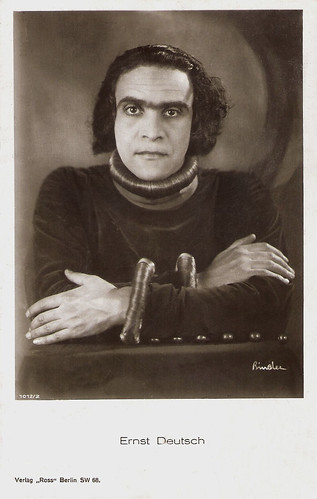
Before Conrad Veidt was cast, screenwriter Hans Janowitz intended the part of Cesare to go to his friend, actor Ernst Deutsch.

In the end, Deutsch did not get to participate in the filming, and the film was created as we know it now, a hundred years later.
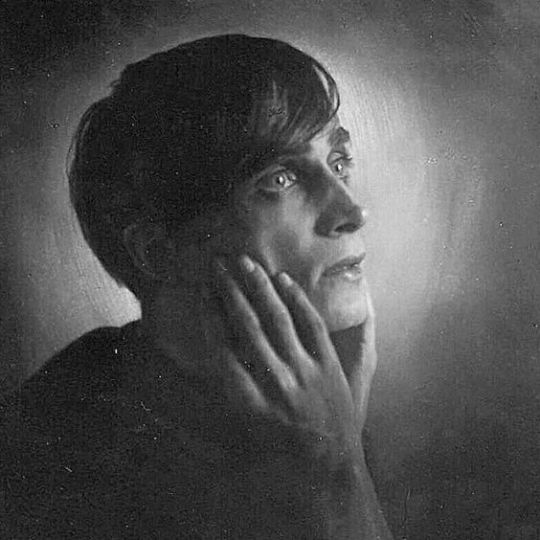
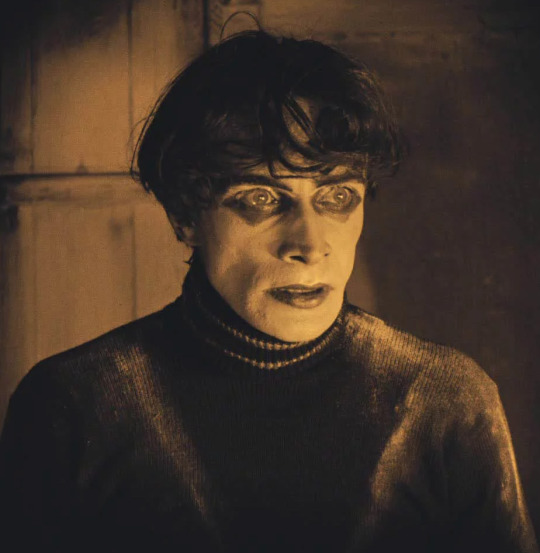
(whispers to the side) On my own behalf, I will add that in the case with the participation of Deutsch, it is unlikely that Cesare would have made such an impression on me as Cesare performed by Veidt. Conrad was like created for this role. This is my opinion, I do not impose it on anyone!
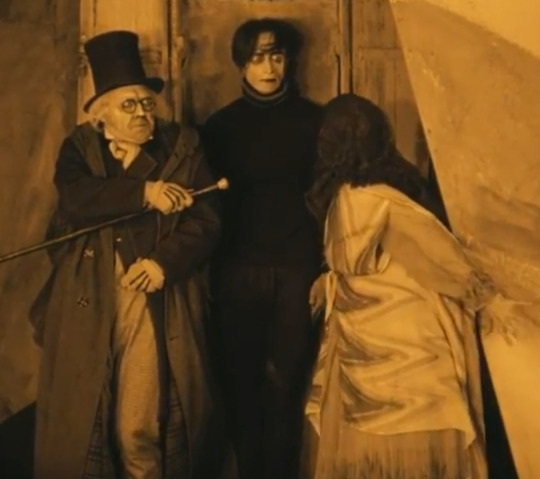
#conrad veidt#the cabinet of doctor caligari#cesare#cesare the somnambulist#Ernst Deutsch#Hans Janowitz#german expressionism#expressionism#the cabinet of dr. caligari 1920
56 notes
·
View notes
Text
Das Cabinet des Dr. Caligari

The Cabinet of Dr. Caligari
🇩🇪 | Feb 27, 1920
directed by Robert Wiene
story by Hans Janowitz and Carl Mayer
produced by Decla Film Gesellschaft Holz
starring Werner Krauẞ, Conrad Veidt, Friedrich Feher, Lil Dagover, Hans Heinrich von Twardowski
1h18 | Crime, Drama, Horror, Thriller
𐄂 not watched
Browse through collections
German Movies | director Robert Wiene | writer Hans Janowitz | writer Carl Mayer | studio Decla Film Gesellschaft Holz | actor Werner Krauẞ | actor Conrad Veidt | actor Friedrich Feher | actress Lil Dagover | actor Hans Heinrich von Twardowski
Browse through genres
Crime | Drama | Horror | Thriller
Links
trakt.tv | letterboxd
#German Movies#Robert Wiene#Hans Janowitz#Carl Mayer#Crime#Drama#Horror#Thriller#Decla Film Gesellschaft Holz#Werner Krauẞ#Conrad Veidt#Friedrich Feher#Lil Dagover#Hans Heinrich von Twardowski
3 notes
·
View notes
Text
The Cabinet of Dr. Caligari (1920)

Although it doesn’t contain the types of scares modern-day audiences are used to, The Cabinet of Dr. Caligari has a haunting, eerily chilling quality. This movie is over a hundred years old. Everyone who starred in it, who was behind the camera when it was made, who saw it upon its initial release is dead and gone. All that’s left of them are these strange images in this imaginary story. No one involved could’ve imagined that a century later, their work would still be influential. Made before sound recordings or colour cinema was possible and before modern-day cinematic techniques were established, it looks unlike anything you’ve ever seen. Combined with its subject matter, The Cabinet of Dr. Caligari feels less like a movie from long ago and more like a glimpse into another reality.
Told in flashback, the story takes places in Holstenwall, where the town fair is in full swing. Francis (Friedrich Fehér) and his friend Alan (Hans Heinz v. Twardowski) attend a new attraction presented by Dr. Caligari (Werner Krauss). He commands a somnambulist named Cesare (Conrad Veidt) to tell audiences about the future. Cesare’s predictions of death prove to be true: there is a serial killer in Holstenwall.
The most striking aspect of The Cabinet of Dr. Caligari is the art direction. Buildings lean unnaturally, doorways, stairs, and streets twist like something out of a madman’s notebook. Pieces of furniture are disproportionate to the people who use them. Trees are hardly recognizable as living things. The architecture's angles, curves, and spirals are such that you might not notice a broken window in the background despite it being intact in the previous scene. The shadows are painted, which means people can move through them without disturbing the light. It’s like these places and people are merely fragments of an un-reality, or (appropriately enough) ghosts reliving their actions as best they can considering their life is over. More than an experiment in style, these visuals emphasize the panic Francis and his sweetheart Jane (Lil Dagover) experience as the murders continue. They also employ excellent graphic design techniques. Your eye is naturally drawn to important objects or characters as they follow the bold lines on-screen.
To casual moviegoers, the performances in old films tend to feel over-the-top. We’re used to natural performances, realistic dialogue and sets that mimic our world. Nothing you see in Caligari resembles real life but that’s the point. Even the title cards use a font reminiscent of insane asylum scribbles. The performances turn out to be just about perfect because of how they exaggerated they are. Rather than feel dated, this 1920 film is immediate and mesmerizing.
The Cabinet of Dr. Caligari is the kind of movie you could watch a hundred times and still feel like you haven't seen it all. You can tell why it had an impact on filmmakers like Tim Burton and is very much the sort of movie that makes you repeatedly go "Oh! That's where that's from!" It’s so different from what we’re used to that you cannot forget the way it looks or feels. (On Blu-ray, January 15, 2021)

#The Cabinet of Dr. Caligari#movies#films#movie reviews#film reviews#Robert Wiene#Carl Mayer#Hans Janowitz#Werner Krauss#Conrad Veidt#Friedrich Feher#Lili Dagover#Hans Heinz v. Twardowski#1920 movies#1920 films
10 notes
·
View notes
Text

The Cabinet of Dr. Caligari will be released on 4K Ultra HD + Blu-ray on October 22 via Kino Lorber. Known in its native German as Das Cabinet des Dr. Caligari, the 1920 silent horror classic has been restored in 4K.
Robert Wiene directs from a script by Hans Janowitz and Carl Mayer. Werner Krauss, Conrad Veidt, Friedrich Feher, Lil Dagover, Hans Heinrich von Twardowski, and Rudolf Lettinger star.
Three audio options are included: 2024 orchestral score by Jeff Beal (House of Cards), 2014 orchestral score by Studio for Film Music at the University of Music Freiburg, and 2014 electronic score by DJ Spooky.
Read on for the special features.
Special features:
Audio commentary by composer Jeff Beal
Caligari: How Horror Came to the Cinema
Restoration Demonstration
A demented doctor and a carnival sleepwalker perpetrate a series of ghastly murders in a small community.
Pre-order The Cabinet of Dr. Caligari.
#The Cabinet of Dr. Caligari#the cabinet of dr caligari#robert wiene#werner krauss#horror#classic horror#silent horror#kino lorber#dvd#gift#german expressionism#20s horror#1920s horror#jeff beal#das cabinet des dr. caligari
61 notes
·
View notes
Text
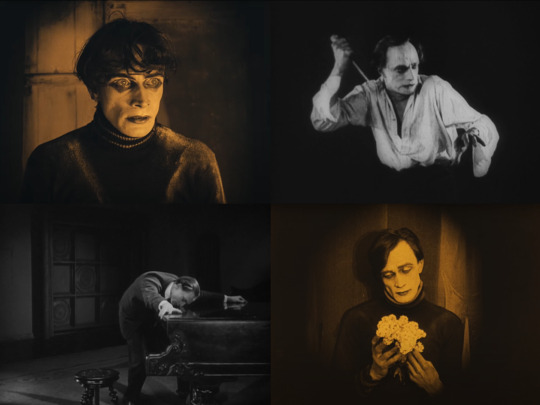
D O U B L E F E A T U R E !
The Cabinet of Dr. Caligari Dir. Robert Weine 1920 // Orlacs Hände (The Hands of Orlac) Dir. Robert Wiene 1924
I recently watched both, Caligari specifically because I was invited on a friend's podcast to talk about the film (I was totally normal about it and definitely didn't make color coded note cards about the making of the movie… I did, I did make color coded note cards). So I figured I would lump these two in one post to switch things up.
--- Even though we talked about the movie for an hour and change, the conversation we recorded for the pod easily could have gone longer. There's so much to unpack about The Cabinet of Dr. Caligari. Between its historical, cinematic, artistic, and cultural significance and legacy, but also the various players on and off camera, not to mention the film's genesis from concept to page to screen -- there's no shortage of rabbit holes to go down.
Something I wish I had brought up during the recording was the score: The score matters! These updated silent film scores really do affect the viewer experience, and they're so often hit or miss. Of course, the original score for Caligari has been lost to time, but I read that the premier of in New York had classical music (Prokofiev, Stravinsky, etc) played along to the screening; part of me thinks this would be fun to try to recreate. I have no memory of the music when I first saw the film in 2009, but when I rewatched Caligari about a year ago, early in my Conrad Veidt journey, I chose a version on Internet Archive (which is, as of late October, sadly still out of commission *cries in nerd*) and the updated score was almost entirely minimal strings, which created a suitably eerie effect. I couldn't find that exact version elsewhere, so I this time opted for the 2014 restoration that's on Kanopy. The 2014 score is… fine. It’s very busy, trying too hard to sound like a traditional movie soundtrack. There's another version with a really painfully bad guitar-heavy score that I couldn't sit through even 5 minutes of, and still another that's entirely synths. Apparently the new 4K UHD/Blu-Ray that was just released has two new options for the score -- hopefully at least one of them doesn't totally suck!
I noticed deep into my third time viewing the film that I hadn't reached for my phone once. These days, I'll occasionally pick it up and mindlessly scroll through social media while watching a movie. But I think Caligari and a few other silent films require closer attention since they're a purely visual medium. I found myself greedily devouring every frame of Caligari. No shot or scene feels wasted. Honestly, I feel like every movie should be 90 minutes long or less. Anything longer should be turned into a miniseries. But in all seriousness, Caligari is another film I want to physically walk into. It would be pretty easy to recreate these sets, life size in grayscale black and white. The more I think about this, the more I need it. So, so bad.
I also came away this time with a lot of questions, mostly about the main part of the narrative, the story Franzis is telling. But the framing device makes the questions pointless. If the main story is just Franzis's delusion, then the absurdity of the script is totally fine I guess? Except the script that Hans Janowitz and Carl Mayer wrote didn't have Franzis as a patient at the asylum, they hated the framing story twist that was forced on their movie, so all those weird parts of the script and character choices that I'm overthinking and reading too much into are rendered meaningless. It's all in Franzis's head! The story and the characters in it don't matter! Or else are just part of his subconscious! Face palm. Eye roll.
Does the movie even work without the framing device? It would be interesting to show an edited version of the movie without the first and last scenes to someone who's never seen it. And if the twist ending was supposed to dumb down the anti-authoritarian message of the script, I don't know that it's successful. In the end, I still have empathy for Franzis. And we still have an ambiguous ending: Caligari/The Asylum Director looks at Mad Franzis and says, "I know just how to cure him," and there's a creepy iris wipe in on Werner Krauss's face that maybe leads us to think Franzis isn't as delusional as we think he is. So like… even if the whole Dr. Caligari with his sleepy twink in a box story is fake, whatever is happening at the asylum is probably just as messed up if not worse.
Speaking of the twink in a box, I love that Conrad Veidt's German Expressionism is totally different from Werner Krauss's German Expressionism. They both trained and performed with Max Reinhardt, so their foundations as theater actors in the 1910s and 1920s were likely similar. But, regardless or in spite of that shared experience, they are diametrically different human beings and that comes across in their performances in this movie. These two actors are like the textbook definition of "showing" your art vs. "being" your art. Krauss as Caligari is like "ooOOOoo look how ooky spooky and evil I am!", whereas Connie's performance as Cesare, even though it's hyper-stylized, is infused with something deeper, something primal that feels believable in the context of the film.
If Cesare has been asleep his whole life, waking only to be fed Chunky Campbell's Soup and commit murder at Caligari's bidding, then no wonder he reacts the way he does when sleeping Jane finally brings him out of his trance. When she freaks out, he freaks out too because he's had no opportunity to learn how to behave like a human or how to filter his primal emotions in a socially acceptable way. He hasn't lived his life except to be a madman's puppet. He reacts to Jane's panic on instinct and impulse, his desire and fear feel feral, like he's more creature or an animal than a human man. He may not actually want to hurt Jane, but he reacts violently because fight or flight is a basic human stress response! He runs away and eventually collapses because his body can't handle the sudden onslaught of stress and emotion he's never before experienced! And this internal, instinctual tendency to violence is subtly alluded to in the final scene when Asylum Cesare both caresses and slowly picks apart the flowers he's holding. Ahhhhh, I have so many FEELINGS.
And that said… Connie's performance here is wild, but it's real in a way that Werner Krauss's work could never be because Connie was a spiritual humanist who cared deeply for others and Krauss was an anti-semitic piece of shit who therefore could NEVER dig deep enough into his soul or into the collective unconscious the way Connie did to breathe life into his characters. So everything Krauss is doing here and in The Student of Prague is all surface, it's "showing" the audience his training and his actor toolbox rather than bringing a level of honesty and in-the-moment groundedness to these roles.
This is not to say Connie's intense commitment to his work couldn't be, uh, excessive. I really hope Lil Dagover was being serious when she said he would lurk around the studio in character when off camera. Can you imagine? You go up to the craft services table for a snack. Suddenly you feel like you're being watched. You look up and he's looming over you in the shadows, his unblinking glazed eyes boring into your soul. God, I hope this happened and I hope whoever it happened to peed themselves a little.
I also wish we had a behind the scenes photo of Connie in costume with the Cesare dummy. I can't believe someone actually had to make that prop. It'll haunt me forever. (The 1920 Cesare Dummy isn't real, the 1920 Cesare Dummy can't hurt me.)
Bottom line: It's an important film, I appreciate it for both its timelessness and timefullness. But it's not a movie I need to revisit often, regardless of how enchanting Connie's nostril acting may be.
---
The first time I watched The Hands of Orlac, I was floored by the visuals, the staging, and the heavy eroticism. Up until that point, I hadn't seen very many silent films, certainly few as visually striking. I think my initial impressions of this film were somewhat muted on a second watch, but that may just because I knew what to expect.
This time, I wasn't as swept up in the magic of silent era German Expressionist cinema, although stylistically I'm still absolutely 100% obsessed. Art direction wise, this is my favorite between the surviving Wiene-Veidt films (I haven't seen Furcht and I don’t plan to). Orlac is like the darker, sexier, more grown up sister to Caligari's mall goth teen. It's Vampira vs Lydia Deetz.
Orlac is just as much if not more of a cinematic feat than Caligari. The production design and art direction alone feels more mature and in itself tells more of a story.
Very early in the film, we're thrown into a very impressive, very realistic train crash. Opening the movie this way was a really interesting choice -- we don't get to meet the characters before the accident that starts Paul and Yvonne Orlac on their doomed and bizarre trajectory. There is a brief establishing scene of Yvonne reading a really horny letter from her husband, and one of pianist Paul at his final concert before returning home. Then there's a very long sequence of the aftermath of the train crash that almost kills Paul, and this scene brings a level of realism you don't really get in other films of this genre/done in this style. The set construction looks expensive; the mangled train cars piled up in heaps may have been fabricated in the studio, but because of the lighting in the night scene, the billowing smoke from passing locomotives and fires from the crash, it looks pretty damn real for 1924. It's extremely effective and harrowing, especially as Yvonne races to the site of the crash and climbs through the wreckage to try to find her husband. The chaos of the scene, made all the more disorienting by the movement of search lights and the haze of smoke and steam, feels true to life. People are running around, pulling bodies from the ruined train cars, carrying them away on stretchers. Survivors look around dazed, clutching their belongings in shock. It's such a well directed moment in the film, but maybe not the first thing people remember about it. And I think it's inclusion is important because it offsets how weird the movie's about to get.
And boy, does it get weird. However, the doctor does say Paul suffered a skull fracture, so it's not a huge stretch to think he also has some kind of brain injury. So I wonder if that has something to do with how the filmmakers chose to show Paul's intense fear and paranoia, as well as the movie's shift in tone and style after his accident. The nightmarishness of the film, from the exaggerated performances to the set design, feels like an extension of whatever might be going on in Paul's head as a result of his injury.
Regardless, I love the choices the art director made. The set, especially the Art Deco mausoleum the Orlacs have for a home, is so perfect. The huge, cavernous rooms are completely unnecessary, but they make the characters look and feel so helpless, like dolls in a doll house. The lines of the walls and the furnishings draw the eye through the frame with just as much intention as the painted sets of Caligari. Even places outside their house become symbolic and iconographic. The news stand is just a window cut out of a massive wall of loose sheets of newspaper that takes up the entire frame. The interior of Orlac Sr.'s house is like a old, drafty castle, looking more like the home of an evil, miserly king. The tavern where Paul is confronted by Nera feels dank and subterranean, just a lamp or two removed from literal catacombs. The outer world is fully a reflection of poor Paul Orlac's inner torment and despair and I AM LOVING EVERY MINUTE OF IT.
The new music composed by Paul Mercer is perfect, too. It's all skronky violins and cellos, ominous percussion and piano. It's just atmospheric enough, creating moments of soundscapes, echoing footsteps, aural suggestions of the oppressive cave-like rooms where the story unfolds. There aren't really any memorable themes like in the updated score for The Student of Prague, but that works for this movie. I would buy this soundtrack and actually listen to it on its own, it's that good.
Everyone in the ensemble is basically on the same page in terms of acting style, no one feels out of place or miscast. Connie of course steals the show, but Alexandra Sorina as Yvonne gives him a run for his money. She's a good match for him, delivering an appropriately desperate and hysterical (and deeply, deeply horny) performance as the touch-starved wife. Their scenes together are maybe some of the best on screen romantic moments of Connie's silent film work because these two are wildly hungry for each other. This movie is so funny, it tells you immediately how horny it is; in the first 30 seconds of the movie, Yvonne gets a letter from Paul that says, "I will feel your body beneath my hands," like they're telling you straight up this is going to Horn Town. And the way she grabs at him, presses her open mouth to him, hovers over him in his hospital bed, she is DTF anywhere any time. And no shame, no shade, good for her. This is a sex positive film, and we love to see it. But she's not just the sexy wife, she's also totally ride or die for Paul. She truly trusts him and believes his absolutely buck wild story about being blackmailed by a dead psycho killer. What a gal.
Then there's Paul, aka Eraserhead Baby… because when he wakes up from surgery covered in bandages, he looks like the Eraserhead Baby. Connie is doing some of his finest nostril acting in this role, I have to say. As always, I am fascinated by his physicality and the choices he's making with movement and gesture. When his bandages are finally removed, he reacts as though drugged, his movements slow as though underwater or in a dream. And when he confronts his surgeon after discovering the original owner of his newly transplanted hands, he holds them out and away from his body as if they were coated in something dirty or disgusting. As Paul's life and sanity unravel, his hands and fingers are in almost constant motion, curling, twitching, clutching; his body language becomes more creature-like, moving in a way that calls up Cesare the sleepwalker -- interestingly, the two characters both seemingly at the mercy of forces outside their control.
We don’t get to know what Paul was like before the accident, how much this traumatic event changed him. There's something this movie is trying to say about trauma and how it affects people. The doctor tells Paul, "Nature and a strong will can overcome anything." But if Paul sustained any kind of serious brain damage, who’s to say his personality wasn't affected, or that he wasn't fragile and suggestible to begin with? Either way, in the wake of the accident, Paul's vulnerability and circumstance makes him a perfect target for Nera's grift.
Even without being targeted by a sick weirdo con artist, it's no wonder Paul's really going through it. He tortures and punishes himself relentlessly for something that wasn't his fault! (Been there.) He puts on a recording of one of his old concerts and crumples in grief for having lost not only his livelihood but also his outlet for creative expression -- not being able to do what you used to creatively because of trauma is REAL. He's trapped in his misery. Even his handwriting is different, now a violent scrawl he imagines is due to the murderous acts his hands supposedly committed. He secretly retrieves the planted murder weapon in order to further convince himself he's somehow become evil, wielding it as through he committed the crimes of the dead man whose hands now belong to him. And the scenes where Yvonne comes to him, wanting to both devour and comfort him, he cannot bring himself to touch her. Clearly they love each other very much and their relationship was very physical, so the agony and yearning in his face when she embraces him is UGH IT'S SO GOOD. It's heartbreaking. There's a lot to unravel here about trauma, body dysmorphia, and intimacy that I'm interested to dig into during subsequent viewings.
Final thoughts: There's an annoying part of my brain that wants the movie to make sense, for the timeline to be clearer, for loose ends to be tied up. But I know that none of that really matters because this movie is better received as a dream or a nightmare. And by that logic, it doesn't have to make sense. The Expressionist beats are being hit particularly hard, but the surreal quality allows the filmmakers and cast to get away with it. For fans of Conrad Veidt, this is a must-watch, even before Caligari -- he gets more screen time in this film, gets to play with his silent film artist's palette, and gets to do pathos like he's the king of tragic, pathetic characters. He's gangly, glassy-eyed, and trembling like a small wet dog the whole time and it's superb. Despite not really getting a chance to know the Orlacs before they're thrown into their own personal hell of body horror and credit debt, they're both pretty sympathetic. From psychological commentary to the erotic visuals and tension, it's all very ahead of its time.
30 notes
·
View notes
Text


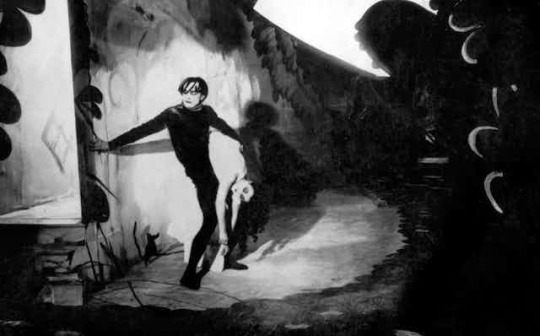
The First Horror Movie
The Cabinet of Dr.Calligari
Director and German Expressionist Robert Wiene makes use of expressionist architecture and narrative through extreme distortion of both the physical set of the movie and it’s plot. The Cabinet of Dr.Calligari is famously recognized as the very first horror movie made in 1920 written by Hans Janowitz and Carl Mayer. The Story follows Cesar, a sleepwalker and his keeper, Dr.Calligari. Cesar is said to be all knowing and is later revealed as a murderer.
#art history#art#history#european art#modern art#cinema#cinephile#film#film history#horror#horror art#horror movies#silent movies#german art#german expressionism#expressionism#1920s movies#the cabinet of doctor caligari#cesare the somnambulist
297 notes
·
View notes
Text
ᴍʏ ꜰᴀᴠᴏᴜʀɪᴛᴇ ᴍᴏᴠɪᴇs










𝐓𝐡𝐞 𝐂𝐚𝐛𝐢𝐧𝐞𝐭 𝐨𝐟 𝐃𝐫. 𝐂𝐚𝐥𝐢𝐠𝐚𝐫𝐢 (𝟏𝟗𝟐𝟎) dir. Robert Wiene, w. Hans Janowitz Silent horror, German Expressionist horror, Weimar cinema
A quintessential work of early German Expressionist cinema, igniting the era of Weimar not long after the country suffered an aggravating loss in the First World War. Citizens left disenfranchised by governing bodies took it upon themselves to express their abandonment and feelings of hopelessness through creative projects that are now classified as important works of art in cinematic history.
#the cabinet of dr. caligari#weimar#german expressionism#horror#silent movies#1920s#german cinema#cinema#film#film history#classic cinema#silent horror#history#robert wiene
12 notes
·
View notes
Note
follow up to my previous ask:
do you have a specific performance of act iii that you think is best?
also throwing in that i am partial to Das Rheingold…any other 18th/19th century German (or otherwise) composers you recommend?
The Karajan recording with the Berliner Philharmoniker is my absolute favorite Ring Cycle. People call it the "chamber" version because it's a studio recording with a more intimate feel to it, and the interpretations and vocal cast are just fantastic. I have a particular affection for the soprano Gundala Janowitz (Sieglinde) and the unique tenor Gerhard Stolze (Loge/Mime).
As for other composers, you'd probably appreciate Bruckner, who was a dedicated Wagnerite. His Symphony No.4 (Romantic) is simply majestic and has one of my favorite finales of any symphony. He was also a devoted Catholic and composed a healthy collection of masses and choral settings.
youtube
The anti-modernist Hans Pfitzner composed an opera (he called it a Musical Legend) based loosely on Palestrina, and it follows the general formula of the late Wagnerian style (people like to meme on it by saying it's Parsifal without the laughs). As a drama, it is rather mediocre (the climax is at the end of the first act), but as a musical work I think it's incredibly enjoyable.
youtube
Mahler took the Wagnerian idiom and applied it to the symphony as well. His gargantuan Symphony No.2 (Resurrection) explores the challenges of the meaning of death and hope in everlasting life, and it strikes me as a work that you cannot listen to and walk away unchanged. (I've heard a running joke that while we might not know what Heaven looks like, if Mahler was even close then it's tuned to E-flat.) This recording is certainly not the best, but it's my favorite (movement timestamps in the comments).
youtube
And of course there's the Schubert, who I probably relate to most closely of any other composer. He has a sensitivity and intimacy that I think is hard to match, especially in his piano sonatas. The B-flat major continues to be my favorite. The work shifts harmonically all over the place, and it's a beautiful fusion of the late classical style with the romanticism of the 1800s.
youtube
I'll stop there or I'll end up listing all the hundreds of composers I regularly listen to from Bach to Pärt, but these are at least in the general periphery of Wagner.
9 notes
·
View notes
Note
what are some facts about the cabinet of dr caligari that u know
• the writers very much disliked the plot twist at the end and stated it was forced on them
• The story took inspiration from a real life events the writers witnessed. hans janowitz believed he witnessed a murder at a fair. he saw a girl disappear with a man and learned she was murdered at the fair the next day.
• a lot of the details of the production of the film are unknown because there are a lot of conflicting stories
• one french theater played it for 7 years straight
• before the films release, posters were hung all around that read “du musst caligari werden” with no further explanation
• conrad veidt stayed in character the whole time and would scare the other cast members lol
• don’t know much about this but i remember reading something about there being deleted scene with alan’s ghost at one point
• the most popular interpretations of this movie include it being meant to be a commentary on war or the state of germany at the time, with caligari representing the government/authority and cesare representing the common man blindly following orders. Janowitz has stated cesare represents a common man being conditioned to kill (like soldiers in war training) and caligari the government sending them off to war/death
#here’s a few#i need to learn more caligari trivia i suprisingly don’t know a ton#veidtnation#the cabinet of dr caligari#asks
99 notes
·
View notes
Text
On February 26, 1920, The Cabinet of Dr. Caligari premiered in Berlin, Germany.

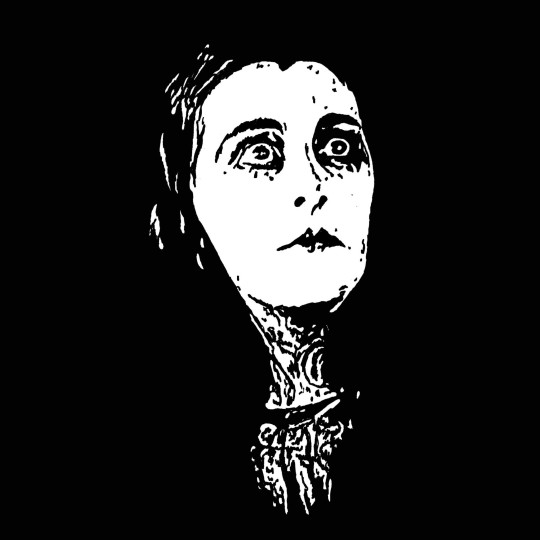



#the cabinet of dr. caligari#the cabinet of doctor caligari#robert weine#conrad veidt#hans janowitz#carl meyer#german expressionism#german expressionist film#psychological thriller#horror#horror movies#expressionist film#1920s#lil dagover#movie art#art#drawing#movie history
5 notes
·
View notes
Text
THE CABINET OF DR. CALIGARI (1920) – Episode 198 – Decades of Horror: The Classic Era
“I must know everything. I must penetrate the heart of his secret! I must become Caligari!” Du musst Caligari werden! Oops! Got carried away. Join this episode’s Grue-Crew – Daphne Monary-Ernsdorff, Chad Hunt, Jeff Mohr, and guest Eli Mohr – as they take in this silent classic fueled by German expressionism, The Cabinet of Dr. Caligari (1920).
Decades of Horror: The Classic Era Episode 198 – The Cabinet of Dr. Caligari (1920)
Join the Crew on the Gruesome Magazine YouTube channel! Subscribe today! And click the alert to get notified of new content! https://youtube.com/gruesomemagazine
ANNOUNCEMENT Decades of Horror The Classic Era is partnering with THE CLASSIC SCI-FI MOVIE CHANNEL, THE CLASSIC HORROR MOVIE CHANNEL, and WICKED HORROR TV CHANNEL Which all now include video episodes of The Classic Era! Available on Roku, AppleTV, Amazon FireTV, AndroidTV, Online Website. Across All OTT platforms, as well as mobile, tablet, and desktop. https://classicscifichannel.com/; https://classichorrorchannel.com/; https://wickedhorrortv.com/
Synopsis: Hypnotist Dr. Caligari uses a somnambulist, Cesare, to commit murders.
Directed by: Robert Wiene
Writiten by: Carl Mayer and Hans Janowitz
Produced by: Rudolf Meinert (uncredited), Erich Pommer (uncredited)
Cinematography by: Willy Hameister (photography)
Production Design by: Walter Reimann, Walter Röhrig, Hermann Warm
Set Decoration by: Hermann Warm (uncredited)
Costume Design by: Walter Reimann (uncredited)
Selected Cast:
Werner Krauss as Dr. Caligari
Conrad Veidt as Cesare
Friedrich Feher as Franzis (as Friedrich Fehér)
Lil Dagover as Jane Olsen
Hans Heinrich von Twardowski as Alan (as Hans Heinz v. Twardowski)
Rudolf Lettinger as Dr. Olsen (as Rudolph Lettinger)
Rudolf Klein-Rogge as Ein Verbrecher / A Criminal (uncredited)
Hans Lanser-Ludolff as Ein Alter Mann / An Old Man (uncredited)
Henri Peters-Arnolds as Ein Junger Arzt / A Young Doctor (uncredited)
Ludwig Rex as Ein Mörder / A Murderer (uncredited)
Elsa Wagner as Die Wirtin / The Landlady (uncredited)
Special guest Eli Mohr picked The Cabinet of Dr. Caligari (1920) for the Classic Era Grue Crew to discuss this episode. They first tackled this landmark silent horror film almost eight years ago in episode 13, although only two of those crewmembers remain. It’s high time the OG crew members, now with eight years more experience, revisit the film with the added benefit of the fresh viewpoints from the “newer” half of the crew. This ultimate example of German expressionism again wows the Grew Crew, old and new alike. The acting, the visuals, and the heartbreaking story intrigue and fascinate right to the very end. There’s so much to talk about. You must become Caligari! Du musst Caligari werden!
At the time of this writing, The Cabinet of Dr. Caligari (1920) is available to stream from Kanopy, Hoopla, JustWatchTV, Shudder, Screambox, and PPV. It is also available on physical media as 4K UHD-formatted and standard Blu-ray-formatted discs from Kino Classics.
Gruesome Magazine’s Decades of Horror: The Classic Era records a new episode every two weeks. Next in their very flexible schedule – this one chosen by Chad – is Night of the Big Heat (1967). Terence Fisher directs Christopher Lee, Peter Cushing, Patrick Allen, Jane Merrow, & Sarah Lawson. They’re on an island. It’s hot, really hot. Everyone sweats. A lot! Then it rains. Don’t worry. We’ll find plenty to discuss.
Please let them know how they’re doing! They want to hear from you – the coolest, grooviest fans: leave them a message or leave a comment on the Gruesome Magazine YouTube channel, the site, or email the Decades of Horror: The Classic Era podcast hosts at [email protected]
To each of you from each of them, “Thank you so much for watching and listening!”
Check out this episode!
4 notes
·
View notes
Text
Dread by the Decade: Das Cabinet des Dr. Caligari
👻 You can support me on Ko-fi ❤️

★★★★½
Plot: When a carnival comes to town, its somnambulist begins predicting people's deaths.
Review: Tense, layered, and stylistically gorgeous, this movie's status as a cornerstone of horror cinema is more than deserved.

English Title: The Cabinet of Dr. Caligari Year: 1920 Genre: Psychological Horror Country: Germany Language: Silent Runtime: 1 hour 14 minutes

Director: Robert Wiene Writers: Carl Mayer, Hans Janowitz Cinematographer: Willy Hameister Composer: Giuseppe Becce Cast: Werner Krauss, Conrad Veidt, Friedrich Fehér, Lil Dagover

------
Story: 3/5 - While interesting and unpredictable, it grows somewhat muddled towards the end and falls into ableist tropes.
Performances: 4.5/5 - Krauss plays Dr. Caligari in the most delightfully maniacal way, and Veidt is unsettling as the clairvoyant Cesar.
Cinematography: 5/5 - Eerily beautiful, with unique framing and lighting. There isn't a single shot in this film that isn't striking.

Music: 4/5 - Wonderfully weird.
Sets: 5/5 - From the cityscapes to the carnival, all of the sets are distorted and angular, giving every shot an unsettling, dream-like quality.
Costumes, Hair, & Make-Up: 4/5 - Very solid. Dr. Caligari's outfit and make-up are iconic.
youtube
Trigger Warnings:
Mild violence
Ableism against mentally ill people (uncritical)
#Das Cabinet des Dr. Caligari (1920)#Das Cabinet des Dr. Caligari#The Cabinet of Dr. Caligari (1920)#The Cabinet of Dr. Caligari#Robert Wiene#gothic#thriller#psychological horror#Dread by the Decade#review#1920s#★★★★½
28 notes
·
View notes
Text
thinking about caligari production ✨lore✨ again
so
this is german actress gilda langer
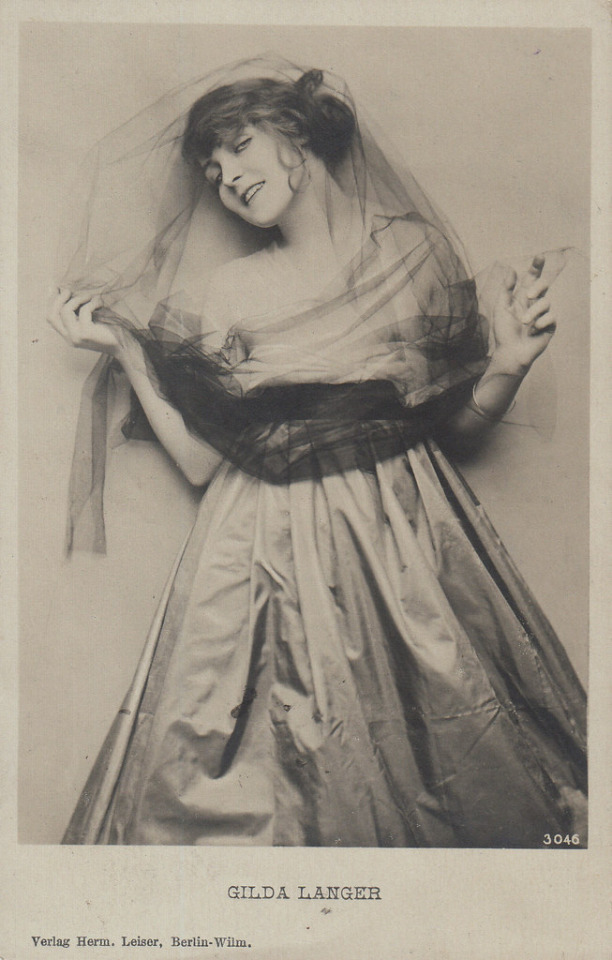
(she was the one who encouraged hans janowitz and carl mayer to write a film together, which would end up being “caligari.” everyone say, “danke schön, gilda langer.”)
when mayer and janowitz were writing “caligari,” they initially wrote the role of jane for langer. however, langer unexpectedly died of spanish flu before they could begin filming, so the role went to lil dagover.
so uh. this happened:

(before she died, langer was also engaged to director paul czinner.)
so, as for the film itself, in the original draft of “caligari,” the frame story element still exists, but francis and jane are a married couple telling the story to their guests at a dinner party years after it happened. however, in the final film, while the characters are friends in the frame story, they are both revealed to be asylum patients at the end. francis asks jane to marry him, but she rejects him, seemingly lost in her own delusion.
so I have a lot of questions. I have to wonder if, considering langer’s untimely death and the fact that she didn’t return mayer’s feelings for her, the way jane’s character was written changed. we know janowitz and mayer did not want the asylum ending, which was added to distill the film’s anti-authority themes. but as for jane rejecting francis, this element stands out to me because we hardly ever see the “damsel” character reject the male protagonist, especially in older works of fiction. what’s also fascinating is that while francis and alan appear to compete for jane’s affection, alan dies, but this doesn’t mean jane chooses francis. what’s curious as well is that even in francis’ own narrative which he controls, he could tell the story so that jane is attracted to him, but he doesn’t.
furthermore, while I’ve touched on this before, even in his own story, francis sort of fucks up his own friendship with jane. after she’s kidnapped, he immediately denies her (correct) account of what happened, leading both her and her father to appear angry with him. francis never apologizes for this mistake, but the fact that we see the olsens upset with him suggests that we’re supposed to see this as a fault on his behalf.
so, between the “love triangle” element in which the “rival” is killed, the fact that francis is rejected and jane remains single, and the fact that their friendship is presented as flawed, I have to wonder how much of the story of the final film may have been impacted by langer’s engagement and death. this is not to suggest that mayer may have had resentment for czinner or langer, or to make any assumptions on his personal life and thoughts towards these people, but it’s curious that while francis and jane started out as a couple in the original draft, francis’ feelings turn out to be unrequited in the final film. could jane’s refusal of him be a projection of mayer’s own unrequited feelings for langer? I have no idea, but I have to wonder
#the cabinet of dr. caligari#rambles#another thing too is that in the og draft#the kidnapping scene is far more . sexual. with cesare in a clearly aggressive role#but in the film it’s a lot more ambiguous as to what’s going on in his head#he looks more panicked than predatory I think#so I have to wonder too if after langer’s death. if portraying a character based on her violated like that#would have seemed to be in poor taste by the writers#I don’t know! all I’m doing is speculating#but it’s interesting that the scenes with jane were revised so heavily
14 notes
·
View notes
Text
The Top 40 Most Popular Operas, Part 4 (#31 through #40)
A quick guide for newcomers to the genre, with links to online video recordings of complete performances, with English subtitles whenever possible.
Donizetti's Don Pasquale
Another comedy of manners with a melodic bel canto score.
Teatro Lirico di Cagliari, 2003 (Alessandro Corbelli, Eva Mei, Antonino Siragusa, Roberto de Candia; conducted by Gérard Korsrten)
Verdi's Macbeth
The first of Verdi's great Shakespearean operas.
Zürich Opera, 2001 (Thomas Hampson, Paoletta Marrocu, Roberto Scandiuzzi, Luis Lima; conducted by Franz Welser-Möst)
Beethoven's Fidelio
Beethoven's only opera, a drama of love, courage, and idealism in the face of political corruption.
Vienna State Opera, 1979 (Gundula Janowitz, René Kollo, Hans Sotin, Manfred Jungwirth, Lucia Popp; conducted by Leonard Bernstein)
Gounod's Faust
One of the most wildly popular operas in the 19th and early 20th centuries: a melodic French interpretation of the Faust legend.
Vienna State Opera, 1985 (Francisco Araiza, Gabriela Benacková, Ruggero Raimondi; conducted by Erich Binder)
Richard Strauss's Salome
Strauss's one-act operatic translation Oscar Wilde's erotic and powerful Biblically-inspired play.
Teatro Comunale di Bologna, 2010 (Erika Sunnegårdh, Mark S. Doss, Robert Brubaker, Dalia Schaechter, Mark Milhofer; conducted by Nicola Luisotti)
Puccini's Gianni Schicchi
Puccini's only comic opera, a rollicking one-act farce inspired by a passage from Dante's Divine Comedy.
Teatro alla Scala, 2008 (Leo Nucci, Nino Machiadze, Vittorio Grigolo, Cinzia De Mola; conducted by Riccardo Chailly)
Verdi's Don Carlo
A grand, tragic historical drama of politics, love vs. duty, intergenerational conflict, friendship (of the vaguely homoerotic variety), and abuse of power.
Metropolitan Opera, 1983 (Plácido Domingo, Mirella Freni, Nicolai Ghiaurov, Louis Quilico, Grace Bumbry, Ferruccio Furlanetto; conducted by James Levine)
Bellini's Norma
A great bel canto soprano vehicle, depicting a tragic love triangle amid the Roman conquest of Gaul.
Sydney Opera House, 1978 (Joan Sutherland, Margareta Elkins, Ron Stevens, Clifford Grant; conducted by Richard Bonynge)
Richard Strauss's Ariadne auf Naxos
A unique "opera within an opera" that explores the themes of comedy vs. drama and "low art" vs. "high art."
Salzburg Festival, 1965 (Hildegard Hillebrecht, Sena Jurinac, Reri Grist, Jess Thomas; conducted by Karl Böhm)
Gluck's Orfeo ed Euridice (Orpheus and Eurydice)
A groundbreaking early Classical interpretation of the Orpheus myth, replacing the pageantry of Baroque opera with "noble simplicity."
Feature film, 2014 (Bejun Mehta, Eva Liebau, Regula Mühlemann; conducted by Vaclav Luks) (no subtitles; read the libretto in English translation here)
#opera#top 40#31 through 40#video#complete performances#english subtitles#don pasquale#macbeth#fidelio#faust#salome#gianni schicchi#don carlo#norma#ariadne auf naxos#orfeo ed euridice
18 notes
·
View notes